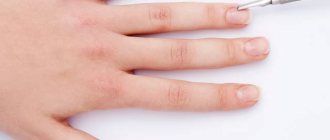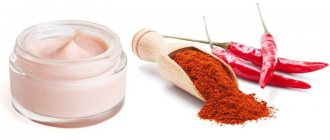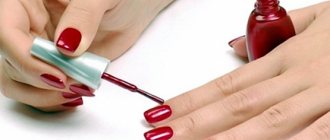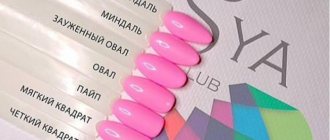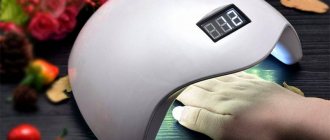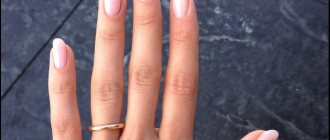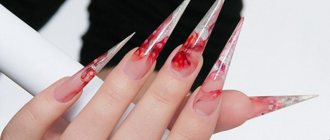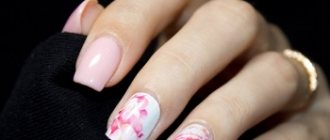Every modern nail salon has an ultraviolet lamp in its arsenal. It is used to dry applied shellac or nail extensions. For home use, the device is a little expensive, so even if you purchased it, you want to use it longer.
If a lighting element fails, repair organizations will require at least half a thousand rubles for repairs, but at home, with the necessary knowledge, costs can be reduced significantly. In addition, by purchasing the appropriate parts, you can even assemble such a lamp yourself.
How to change it in UV with your own hands - step-by-step instructions
To replace an outdated or burnt-out lamp in the device, you must follow these steps:
- Turn off the device using a special button, if available, and disconnect from the network. Turn the box over, unscrew all the retaining parts of the base and cover of the case, for convenience, place the screws in a small closed container or matchbox so that they do not get lost.
- The device turns over into its usual position with support for the lower part of the block so that it does not fall off and the existing parts are not damaged.
- Carefully remove the top of the device. This should be done easily, without crackling, extraneous sounds, etc. The main thing is not to damage fragile lamps and electrical contacts.
IMPORTANT! As a rule, connecting wires are attached to the rear wall at the top of the case, leading to the control buttons from the board located on the base. Therefore, the cover should open “like a door” with minimal movement of parts of the housing so that the wires do not come off. Then it will be difficult to connect them without special equipment.
- A non-working or outdated lamp is identified and is very easily pulled out of the socket so that it does not crack in your hands, since the base is usually hidden inside a mirror structure in order to less scatter the emitted ultraviolet rays.
- In place of the old lamp, a lamp of similar power and dimensions must be inserted in order for the device to work correctly. The part is simply placed in the socket at the appropriate joints, easily pushed all the way so that the metal contacts are installed in place.
REFERENCE! Depending on the design of the device, to replace the UV lamp, you don’t have to disassemble it, but simply remove the damaged one and insert a whole lamp in its place. The main thing is that at this moment the device is disconnected from the network. It is easier to remove the lamp if you push it with your finger from the back of the socket, then you do not need to squeeze the glass bulbs. Unwinding the equipment reduces the risk of damaging the fragile glass in your hands.
- Close the top cover of the device so that the housing snaps into place. Typically, manufacturers produce plastic devices with self-locking box parts, and screws are provided for secure fastening.
- Before screwing in the device, you can check that the new lamp is connected correctly; to do this, you need to make sure that no wires are sticking out of the case, connect the equipment to the network, and press the power button. If the lamp does not work, you should turn off the device, lift the cover again and check the integrity of the installed lamp and its correct connection.
- All screws are inserted into place and screwed securely.
IMPORTANT! If the device body is plastic, and the screw socket on the body is not equipped with a metal insert (this is the case with most devices), you should control the degree of tightening of the bolts so as not to cut off the plastic threads or split the fasteners.
How to change in ICE?
Lamps for manicure based on conventional tube ultraviolet lighting elements are considered more outdated compared to their analogues with LEDs or, as they are also called, LED lamps. There are no individual LEDs that are used in manicure machines available for free sale. Therefore, to replace damaged elements, you will need a “donor” - a broken or the cheapest lamp in the segment.
To replace you will need: an iron, a powerful soldering iron, a screwdriver, wire cutters, a utility knife, an LED lamp with a burnt out or lost element, a “donor” device for LEDs, tweezers, fluxes, resealable small containers for LEDs and device bolts, preferably 2 for each device so that small elements do not get lost. All actions are performed according to the following instructions:
- The housing of both lamps is disassembled one by one. To do this, you need to find the exits of the screw caps, use a screwdriver to unscrew them all, place them in closed containers, you can use matchboxes.
- Carefully open the covers, taking into account that the connecting wires of the top cover buttons and the LEDs on the base are usually short and can easily break.
- Disconnect the connecting cables through the special connectors in order to work only with the base of each lamp.
- The plates on which the burnt or lost LEDs are located are unscrewed.
- Using a heated, powerful soldering iron, the back part of the fixed plate is heated, where the lighting element is supported by tweezers. As a result of sufficient heating, the part should detach on its own. If this does not happen, but some traces of adhesive or other substance remain, you need to use a utility knife or wire cutters to clean the place where the diode is attached, and use a hot soldering iron to remove the excess from the surface of the socket.
- Removing the diodes from the donor device is easier: the board with the lighting elements is removed, the reverse side is placed on the surface of a heated iron, fixed in a rigid position, the edges of the LEDs are coated with flux.
- After 20–25 seconds, remove the part that has come off the board. As a rule, this time is enough, but it is better to always keep tweezers at the ready.
IMPORTANT! Avoid overheating the LEDs, as this may damage them or reduce their service life.
- Before soldering, it is necessary to determine the correct polarity of the LED, usually this is marked on the board, and on the element “-” on the ground corner. The place where the diode is attached is first coated with flux, the part is installed on it, and using a hair dryer or a 60-watt soldering iron, the “landing” point is heated on the back side of the plate.
- The board on which all manipulations were performed should cool to room temperature. After this, the corresponding wires of the housing parts are connected, the device is carefully and very carefully connected to the network and its functionality is checked. If problems are found, it is necessary to find an error in the actions taken.
- If the installed LED works, you should put the lamps back together, clean up the area after yourself, and lay out the tools.
- The device is now ready for use.
How often should you change a light bulb and how do you know when it’s time to change it?
It is almost impossible to predict exactly how and when the lighting element in an ultraviolet lamp will need to be replaced. This depends on the amount of total operating time and the frequency of on-off switching. In home use, you can even wait for a separate illuminator to completely fail, which is unacceptable for salons.
With a busy work schedule, tube-type light bulbs are changed on average 4-6 times a year. This is due to aging lamps that are not able to produce the luminous flux of the required intensity. The gel will take longer to harden. In complex aquarium designs, the bottom layer, with a thick coating, does not harden at all, leaving the thin colored gel mobile.
It is impossible to determine by appearance that the coating technology was violated due to a low-quality lamp, however, the duration of use of the manicure is significantly reduced. Also, the lamps require replacement if they stop drying. They emit normal light without affecting the structure of the gel coating. It can also be determined by the increase in drying time; if it has increased by more than 50% from the nominal value, you should think about purchasing a new lighting point.
Video material
As you can see, there are no special problems in making a manicure machine, but of course, this is not an LED nail lamp. With your own hands you can create a high-quality device for home use and do manicures of any complexity.
Many women visit beauty salons to get their nails done. This process is usually accompanied by the application of a special varnish. Without equipment, it takes a long time to dry. To quickly dry gel polish, use a lamp with ultraviolet light. Its main property is the rapid polymerization process of the applied material. To ensure a high-quality manicure, you need to carefully choose a lamp for drying nail polish. Today there is a wide selection of this product, but you can make a device for drying nails with your own hands.
Do-it-yourself repair of ultraviolet drying gel nail polish
There are several reasons why ultraviolet lamps fail:
- The LED lamp driver burns out.
- The resource runs out and the tubular lamp ceases to perform its functions.
- Any type of lighting element burns out.
- The power supply fails.
To repair, it is necessary to determine the cause and essence of the breakdown. If this is just a burnt-out lighting point, then the easiest way to replace it in tubular UV lamps is by simply replacing it with a new one. In LED lighting devices, it is necessary to completely disassemble the equipment, remove the burnt element, and solder a working element in its place.
If the driver burns out, you should determine which LED has failed. The difficulty is that not all of them light up and it is impossible to visually diagnose the point of failure. To do this, the elements are removed one by one, tested with a multitester and, if they work, soldered back in, the broken one is replaced until the entire device is fully operational.
The power supply can be repaired by a specialized service center or completely replaced at home. As a rule, the structure of a part is complex, and without the necessary skills it will not be easy to understand what exactly is wrong with it.
Types of nail dryers
When creating nail art, it should be taken into account that ultraviolet rays affect each layer of varnish separately. Therefore, the total time for the total effect of ultraviolet radiation on the entire nail plate should not exceed ten minutes. Otherwise, you will violate sanitary standards; your nails and skin may be seriously damaged. If you plan to do a multi-layer manicure yourself, then buy quick-drying coatings.
Currently there are the following types of lamps:
- Ultraviolet dryers. All manicure devices are equipped with fluorescent or LED lamps. But the ultraviolet lamp for drying gel polish is the most affordable. With your own hands, you can use it to create real masterpieces on your nails; the main thing is to use it correctly and not violate established rules and regulations. This model can be purchased on the Internet, a specialized store, or even made by yourself.
Important! Their only disadvantage is the short life of the light bulbs used inside and the content of mercury in them that is hazardous to health.
- LED lamps for nails. Today they are considered the best in this field. Such devices operate using LEDs, so the drying process is completely safe for health, economical, and fast. Polymerization takes place in just 20-30 seconds, meaning there is no need to wait three minutes. There are no harmful substances inside the lamp, so if it breaks, no one will be harmed.
Important! LEDs do not become less powerful over time.
To summarize, it becomes quite clear how they differ. LED lamps are something new for the fashion and beauty industry. Ultraviolet dryers are considered a proven and cheap option, which is once again proven by the current review of lamps for drying nails from various manufacturers. The main advantage of LEDs is their long service life, which devices with fluorescent lamps cannot boast of. But the most important thing is that LED models are absolutely safe.
Important! When planning to make such a device and use it at home,
How to do UV drying with your own hands?
Before you start assembling an ultraviolet nail lamp yourself, you should familiarize yourself with the following features of their launch systems:
- Electronic – characterized by great vulnerability to current surges in the network, lighter and simpler in design.
- Induction is heavier due to starting through the starter and choke, which make the device heavier; after switching on, the light flashes for a while, but is more resistant to mains current surges.
To assemble a UV lamp yourself, you will need to remove the base with the existing system, so it is better to take inexpensive illuminators.
List of required materials:
- Ballast as a ballast for limiting current of induction or electronic type. It is necessary to select this element so that its power matches the corresponding indicators of the lamp used.
- Fluorescent lamps.
- Food grade or self-adhesive foil is used to cover the internal cavity of the device to increase reflectivity.
- The housing is plastic, it can be used from another old device, just adapt it to the characteristics of the lamp.
- Cable with plug for connecting to a 220 V network.
- The control button can be in a standard form with an “On”/“Off” mode in the form of a push or roll type.
- Soldering iron.
Instructions for preparatory work on assembling the ultraviolet lamp housing:
- Calculate the power of the device depending on the number of lamps used. If the lighting element has a power of 9 W, then when installing 3 of them in the device, the total power will be 27 W, with 4 lamps - 36 W, respectively. With higher power, the polymerization rate increases.
- Due to the ability to heat up during lamp operation, you should select a housing that will protect against burns. Thick plexiglass, wooden panels, casings from old unnecessary appliances, etc. work well.
- On paper, draw a diagram of the arrangement of the elements, calculate the number of wires and necessary parts, you should also decide on the appearance of the device, its shape and placement of the illuminators so that they do not interfere with your hands, do not hinder movements and can dry the gel.
- Think about how everything will be attached to the case, make all the spacers, panels, outputs and sockets for lamps, places for laying wires, an outlet for a button and a network cable.
- Cover the inner surface of the case with foil, trying to make it as even as possible, then the light will be better reflected and focused on the nails.
The procedure for assembling the electronic part of the lamp:
- Remove the base from the lamp, to do this, use wire cutters to separate the legs, remove the white base, prying it under the metal rim, after which 4 wires become visible, the first pair of which connected the starter, and the second pair went out to the legs;
- Connect the lamps to each other with wires, connect them to the ballast so that the outputs to the cord are located on one side, and the contacts for connecting the lamps themselves are on the other;
- Connect the cord to the electronic part and connect the button;
- Connect the assembled system to the network and check its functionality;
- Install the previously prepared “filling” into the body.
With certain skills, the duration of the process of assembling the electronic component of the device is approximately an hour. The case will take a little more time, it all depends on the chosen material, mounting methods, and imagination with the design.
Details about ultraviolet lamps for nail extensions
Ultraviolet rays were discovered back in 1801 by the German physicist Johann Ritter. There are three types of ultraviolet waves, and one of them - low beam - is used by manicurists for nail extensions. An ultraviolet lamp for nail extensions is an extremely necessary device for a modern manicurist, and therefore you need to be especially scrupulous in choosing it, since the purchase is not made for one year. Lamps for nail extensions differ in design and technical features. Typically, craftsmen opt for a beautiful-looking, comfortable, lightweight and compact device. But besides this, when purchasing, you need to carefully analyze the technical characteristics of the models so that the ultraviolet lamp for nail extension can work reliably for many years.
The simplest lamp for nail extensions consists of a body and an ignition circuit. The circuit can be electronic or inductive. It has an electronic circuit, is quite light in weight (only one to one and a half kilograms), and operates from a network with a voltage of 180 to 240 volts. The electronic circuit is quite vulnerable - it is highly sensitive to the quality of the supply network and any voltage drop can damage it. The induction circuit is similar to fluorescent lamps; it is resistant to voltage surges in the electrical network, which makes the device more reliable. At the same time, a lamp for nail extensions with an induction circuit has some disadvantages - it is heavy (two to two and a half kilograms), and at low voltage they may not turn on at all. Induction devices are also more expensive than their electronic counterparts.
In ultraviolet lamps for nail extensions, the main function is performed by light bulbs. They vary in power and design. There are straight tubes, U-shaped and H-shaped. The most common U- and H-shaped, straight bulbs are gradually becoming a thing of the past.
The power of the bulbs is indicated on the base. It is worth noting that for devices with an induction circuit, the marking must contain the letter L, this is important, since externally the bulbs for electronic and induction circuits are no different, but if they are mixed up, then ultraviolet lamps for nail extensions will not work. You cannot replace short bulbs with long ones and vice versa - such a purchase will be a waste of money. When replacing a device, technicians can be advised to come to the seller and check their performance upon purchase. This is advisable, since many manufacturers do not adhere to the necessary labeling rules.
When purchasing, you also need to pay attention to the packaging - light bulbs packed in boxes without inner packaging indicate a low level of quality. The better the packaging - the light bulb is in a holder and the manufacturer's brand, etc. is indicated. – the higher the quality of the product. The production culture is responsible for the level of product quality. Accordingly, the higher the production level, the longer the service life of the light bulb.
The main technical characteristic is power. The higher the lamp power, the better for the manicurist. Working with an ultraviolet lamp for nail extensions, like working with any equipment, requires skills. Before a master decides to purchase a device, he needs to decide for what purpose the nail extension lamp will be used. An ordinary 9-watt light bulb is suitable for strengthening nails with biogels, simple modeling with gels and ultraviolet acrylic, as well as for fixing plates when correcting nails in a pedicure. With such a low light bulb power, the exposure time of the material in a nail extension lamp increases at least twice as much as the manufacturer’s recommendation.
It is more convenient for craftsmen to work with more powerful light bulbs - at least 14, and preferably 18 watts (two light bulbs in a 7 or 9 watt lamp, respectively). With such power you can lay out French manicures and building gel. But the holding time of the plates still needs to be increased. The advantage of such lamps is their lightness and mobility, which allows an on-site technician to do the necessary work on building up artificial plates.
The work performed by the device with four nine-watt light bulbs with a total power of 36 watts has proven to be the best. This ultraviolet lamp for nail extension allows you to simulate almost any design of artificial plates, including “aquarium” and thick “glass” topcoats.
More powerful lamps (45 and 54 watts) require the highest level of professionalism from the master. With such a high power, the speed of extensions increases significantly, but the slightest overexposure to ultraviolet radiation threatens delamination and brittleness of the material, as well as its yellowing.
Each UV nail extension lamp is equipped with reflectors. If the lamp is not equipped with them, this indicates a low-quality device that absolutely cannot be used. After all, reflectors perform an important function - they catch all the ultraviolet rays, making it impossible for them to pass by the material. The lower reflector in lamps is usually covered with a film, which should be removed before starting work. Polished metal is considered the best reflector; it doubles the efficiency. Thick mirror foil is inferior in quality to polished metal, and thin metal plates that look like matte silver are the worst reflector.
It is good when the body of the ultraviolet nail lamp is equipped with a removable bottom or protective casing. This allows you to wash the device and change its light bulbs without much effort.
Additional functions of the UV lamp for nail extensions are a timer, a fan and a display. These little things greatly simplify the work of the master and allow the extensions to be performed efficiently and comfortably.
